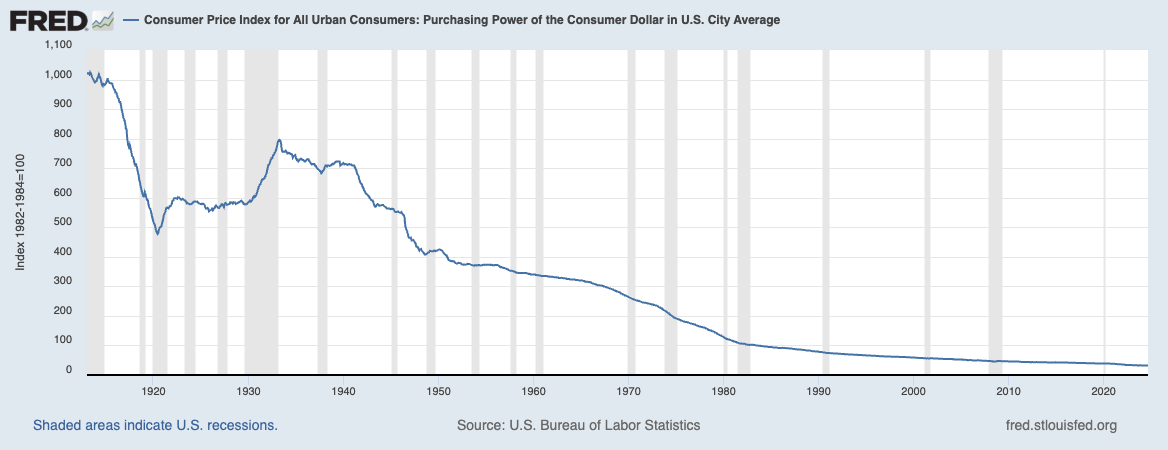Why the “Purchasing Power” Chart Can Be Misleading
Every now and then, a chart depicting the “declining purchasing power” of the US dollar goes viral, especially within the crypto community. At first glance, it seems alarming—one dollar from a century ago buys dramatically more goods than today. The narrative often quickly shifts: holding dollars means you're slowly losing wealth, making alternative assets like Bitcoin or gold appear necessary.

While it's true that a dollar today doesn't go as far as it did a century ago, there's an important nuance these charts miss: cash isn't meant to sit idle indefinitely. Let's unpack why simply looking at purchasing power charts doesn't give you the full story—and why rushing into alternative investments based on fear might not be the most rational choice.
Money Isn’t Usually Left Idle
Economics 101 teaches that money has three core functions:
- Medium of exchange (buying and selling goods and services),
- Unit of account (pricing those goods and services),
- Store of value (preserving wealth over time).
The crucial misunderstanding is treating money strictly as a store of value without context. Sure, inflation reduces the buying power of cash sitting unused over decades—but how many people actually store their wealth as cash under a mattress?
In practice, most people invest their money. Whether it's in bonds, stocks, real estate, or even cryptocurrencies, wealth is typically invested in ways that preserve or increase purchasing power. For example, historically, U.S. Treasury bonds (often viewed as a safe investment) have consistently delivered returns that outpace inflation, preserving or even increasing your real wealth.
An excellent resource for long-term asset returns data is the Historical Returns on Stocks, Bonds and Bills dataset collated by Aswath Damodaran of NYU Stern.
USD Has Actually Held Its Value Relatively Well
Compared to many global currencies that have suffered hyperinflation, defaults, or collapse, the US dollar has actually maintained its purchasing power relatively well. Many currencies from the past century have disappeared altogether, making the dollar’s relative stability exceptional. This stability has allowed investors who hold USD-based assets, like government bonds or stocks, to achieve positive real returns—that is, returns above inflation—over extended periods.
Recognising the dollar's relative resilience doesn’t imply it will always remain stable, nor does it mean one should invest exclusively in USD assets. It simply highlights the importance of diversification and the potential for carefully invested money—even in relatively safe assets—to maintain or grow purchasing power despite inflation.
The Danger of Overreacting to "97% Lost"
The dramatic claim that "the dollar has lost 97% of its value" creates urgency that can push people towards impulsive decisions—such as over-investing in volatile assets. Here’s why that's problematic:
- Cash vs. Invested Capital: The "97%" statistic describes uninvested, idle cash. In reality, invested dollars often grow in value despite inflation.
- Unnecessary Panic: Inflation isn't sudden; it’s a slow, predictable process investors routinely account for through diversified portfolios.
- Misjudging Risks: Pouring one’s life savings into a high-volatility asset on the back of a sensational statistic could be more detrimental than holding a balanced mix of investments.
Crypto's Real Appeal: Ownership and Sovereignty
If panic about purchasing power isn’t the best reason to buy crypto, what is? For many—the real attraction of cryptocurrencies like Bitcoin lies in the unique type of ownership they provide:
- Self-Custody: Unlike traditional financial assets held by banks or brokerage accounts, cryptocurrencies allow genuine personal ownership through private keys.
- Sovereignty and Resilience: Because you directly control your crypto holdings, your access to them cannot be unilaterally revoked by a government or institution. No one can de-platform your Bitcoin if you hold your own keys.
- Borderless Utility: Transferring crypto can happen globally with minimal friction—no intermediaries or complex approval processes.
These attributes make crypto an attractive complement to traditional investments—not a replacement. Instead of viewing crypto purely as a hedge against currency collapse, think of it as adding another valuable layer to a well-rounded portfolio.
The Balanced Approach
In short, the popular purchasing power chart isn’t necessarily wrong—it just presents an incomplete picture. Real-world investing involves actively putting your money to work in diversified assets that generate positive returns.
Whether you're interested in crypto, traditional assets, gold, or a blend of them all, the key is diversification and thoughtful strategy—not fear-driven reactions based on simplistic charts.
Disclaimer: This post is for informational purposes only and should not be considered financial advice. Always do your own research or consult with a financial professional before making investment decisions.